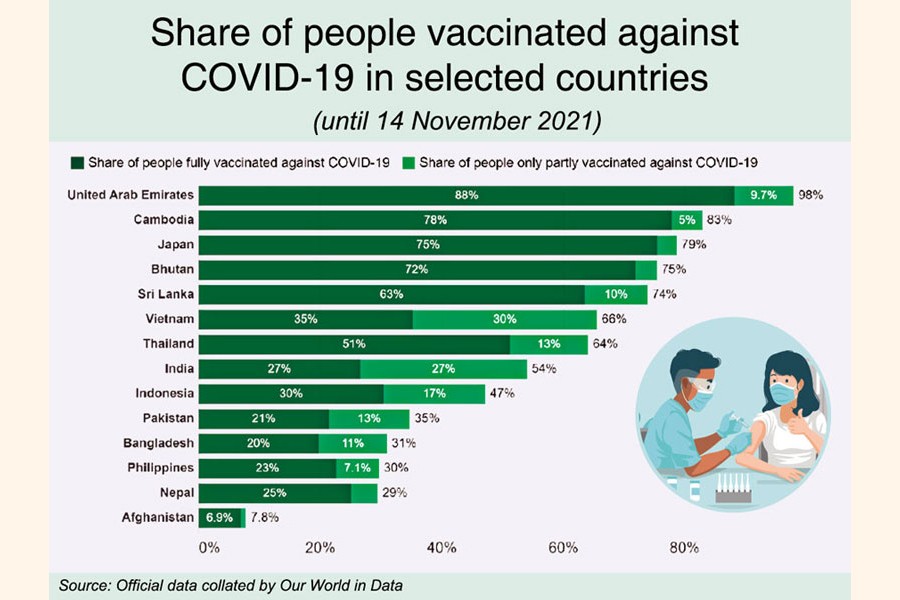
Vaccination acceleration imperative for immunising against Covid
Rabiul Islam Rabi | Wednesday, 8 December 2021

 Accelerating the vaccination rollout is imperative to attain herd immunity against the Covid-19 infections and protect Bangladesh from onslaught of variegated variants of the pandemic virus. But, besides the unavailability of jabs, tackling vaccine hesitancy or people's unwillingness to take vaccines has proven to be a daunting task for Bangladesh, at initial stages in particular. During the pandemic, perhaps, most had heard this striking sentence 'tika lagbena, goribmanush er corona hoyna', meaning the poor do not get infected with coronavirus and hence vaccines are not required for them (!). Even the economically solvent and educated people were hesitant to take vaccines.
Accelerating the vaccination rollout is imperative to attain herd immunity against the Covid-19 infections and protect Bangladesh from onslaught of variegated variants of the pandemic virus. But, besides the unavailability of jabs, tackling vaccine hesitancy or people's unwillingness to take vaccines has proven to be a daunting task for Bangladesh, at initial stages in particular. During the pandemic, perhaps, most had heard this striking sentence 'tika lagbena, goribmanush er corona hoyna', meaning the poor do not get infected with coronavirus and hence vaccines are not required for them (!). Even the economically solvent and educated people were hesitant to take vaccines.
As of the second week of November 2021, only about 20 per cent of the total population were fully vaccinated while nearly 11-per cent people received one shot of the jabs (Figure 1). A cross-country comparison indicates that Bangladesh remains far behind most Asian countries in driving the inoculation campaign.
What drives the willingness to take vaccines? Several studies have revealed that a complex interplay of factors like religious values, perceived efficacy of vaccines and side effects, socio-demographic profile, difficulty in vaccine registration, among others, influence an individual's decision to get a vaccine. In the light of these challenges, this article outlines a few approaches that could be utilised to increase vaccine uptake in Bangladesh.
Using credible and easy-to- understand audiovisual communications: Addressing vaccine hesitancy should be based on socio-demographic contexts. One research has shown that vaccine hesitancy is substantially high among elderly, rural, semi-urban, and slum communities, farmers, day-labourers, homemakers, low-educated groups, and people with low trust in the country's healthcare system. Another study has indicated that people who had difficulty getting pandemic relief support from the government tend to be more unwilling to take a vaccine. These factors need to be taken into consideration while communicating any message on vaccination.
In this regard, it should be kept in mind that due to limited education and illiteracy, awareness message on leaflets or in written documents may not serve to reach low-income and low-educated groups. The attention span has decreased even among the educated masses, and people are now more inclined to listen to catchy audio-visual messages. While some campaigns are underway in various media, there is a severe need to adopt a more creative approach while broadcasting the awareness messages in radio programmes and TV channels.
It is essential to introduce awareness messages in different ways as people tend to avoid an advertisement or campaign message when there is repetition. Switching the artists appearing in the campaigns, changing the type of relevant adverts, and using local languages to relay the information could be tried to maximise the outreach. Places with common TV (hospitals, doctor chambers, shopping malls etc) could also be considered to make people aware of vaccine efficacy and registration through attractive audio-visual messages.
Utilising religious events to raise awareness: Religious events like prayer congregation can act as a catalyst to increase awareness among mass people. Take the case of Friday prayer (known as Jumaah prayer), which sees the largest gathering of Muslim people every week. Except for this Friday prayer, no such event takes place anywhere across the country where a vast mass gathers each week. The imams, who lead the prayer and deliver sermons, also appear to have a good recognition among the Muslims in their respective areas. Their speeches usually inspire people. The imams can dedicate a particular part of the sermons to encourage people to take vaccines and the importance of adhering to health and safety protocols.
Besides Friday prayer, funeral prayers, which also seem to have spiked due to COVID-19 fatalities, can be utilised to motivate people to get vaccines. Most people attending funeral prayers tend to be in a state of listening to the words of the person who leads the prayer. Having a Muslim-majority population, Bangladesh can use such prayer events to fight misinformation and raise public awareness on vaccine intake. With the help of the Ministry of Information and Broadcasting and the Ministry of Religious Affairs, such campaigns can be undertaken to initiate at every mosque across the country. In the case of other religions, the same can be replicated too during their respective events.
Influence of local leaders: In the context of Bangladesh, government officials, local political leaders, and community leaders have influence on their constituency and respective area. Such leaders can be encouraged to spread the message regarding vaccine efficacy and make people aware of taking vaccines. To make this happen, awareness campaigns at regular intervals can be launched to target the areas with a relatively large population with high vaccine hesitancy. Such initiative may not entail any substantial cost as some researches have already identified that people in low-income settings have higher vaccine hesitancy.
Making use of volunteers to ease the vaccine-registration process: Evidence shows the digital registration process for vaccination has been identified as a barrier to taking vaccines among the low-educated group. According to the National ICT Household Survey 2019 data, as much as 65-per cent people in rural areas do not use the internet and about 97 per cent of those aged above 60 years do not have access to the internet. It has also been reported that homemakers, unemployed persons, day labourers, drivers and helpers, and housemaids were the least aware of the registration process.
To ease the registration process, one way forward could be involving the volunteer organisations. Bangladesh has many volunteer organisations that played an important role in relief distribution during the pandemic. Setting up registration booths using the voluntary organisations and local volunteer groups can ease this registration task. A similar campaign was launched on the Dhaka University premises that facilitated the registration process for low-income people like rickshaw-pullers, street vendors etc. The same drive can be replicated using volunteers across the country.
The reasons driving vaccine hesitancy vary from country to country. The abovementioned interventions are based on analyses of recent research that looked into the unwillingness of people to get COVID-19 shots in Bangladesh. Vaccine hesitancy has been found high among low-income and low-educated groups. Raising awareness among these groups would require tailored interventions that can convey credible information, infuse trust, and remove barriers to vaccine access. Such interventions should also help people of other socioeconomic groups who refuse to take vaccines.
Devising easy-to-understand awareness messages targeted to low-income groups, making use of prayer gatherings and Friday sermons, utilising the influence of local leaders at the community level, and leveraging the network of volunteer organisations to expedite the vaccine-registration process can potentially increase the vaccine intake across Bangladesh and chart the way to a faster recovery from the pandemic.
Rabiul Islam Rabi is a Research Economist at Research and Policy Integration for Development (RAPID). This article is a modified version of a write-up on the same topic published in the Development Letters, a quarterly journal by RAPID. The views and opinions expressed are his own and do not represent those of the organisation named.
Email: eco.rabi@gmail.com